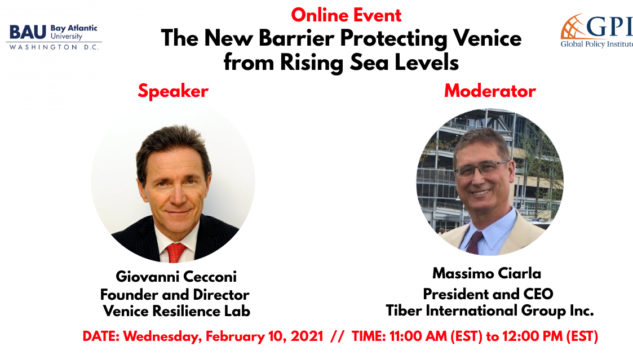Events

The New Barrier Protecting Venice from Rising Sea Levels
On Wednesday, February 10th, at 11:00am (EST) Global Policy Institute and Bay Atlantic University held a joint webinar titled “The New Barrier Protecting Venice from Rising Sea Levels”.
Speaker
Giovanni Cecconi, Founder and Director of the Venice Resilience Lab
Moderator
Massimo Ciarla, President and CEO of Tiber International Group Inc.
Welcoming remarks
Paolo von Schirach, President, Global Policy Institute, and Chair Political Science and International Relations, Bay Atlantic University
An increasing number of coastal cities around the world are threatened by severe sea level rises. To face this threat prevention, adaptation and mitigation solutions are adopted in order to reduce soil erosion and flooding through the integration of protective infrastructures and bio-structured habitats. The three different alternatives for resilient solutions to sea level rise and flooding are: 1) realignment of the areas at risk, whenever economically viable and politically accepted; 2) super-levee, such as the one in Edogawa-Tokyo and suggested for the city of Boston; 3) storm surge mobile barriers, such as the one adopted in Venice, www.mosevenezia.eu and also the Netherlands, Russia, U.K., and New Orleans. The Venice Safeguard Project has been developed over a period of 30 years. It is a combination of storm surge mobile barriers and environmental restoration activities, developed by “Magistrato alle Acque”, the Venetian Water Authority, and by Consorzio Venezia Nuova, a private consortium.
Event Recording:
Event Summary
With the aid of many slides and detailed graphics, Giovanni Cecconi explained how the plan to save Venice from the constant and growing threat of high water relies on the successful integration of different defenses. He discusses the importance of recreating a variety of nature-based bio-stabilizing structures, such as natural barrier islands and wetlands, as well as sophisticated movable physical barriers placed at the openings of the lagoon expressly created to protect Venice from high tides now made worse by rising sea levels caused by global warming. These are the integrated tools devised for the adaptation to sea level rise and flooding protection. The storm surge barriers can also be operated for improving tidal flushing and for limiting the erosion of salt marches and tidal flats. Cecconi explained the special challenges involved in a complex project aimed at recreating and strengthening the natural environment, while at the same time allowing Venice, a unique ancient city built in a lagoon, to thrive as a human settlement. This means reconciling nature and commerce, cruise ships loaded with tourists and the preservation of wetlands. Cecconi described in great detail the various multi-year interventions. He finally presented the original solution of underwater barriers that can be filled with air and rise as a wall so that the Venice lagoon can be effectively sealed when high water that would normally flood much of the city is expected. He also provided interesting comparisons between the Venice barriers and other man-made physical barriers devised in other countries for other major cities facing similar challenges like Rotterdam, Galveston and London. Cecconi pointed out that saving Venice and its surrounding natural environment is “work in progress”. The hydro-geological conditions in the lagoon where Venice is located are constantly changing. Furthermore, as sea levels rise, the city of Venice, built on soft foundations, progressively sinks deeper into the sea. As Cecconi explained, these are enormous challenges. Yet, human ingenuity and creativity devised appropriate solutions that safeguard nature and a historic city.
Speaker:
Giovanni Cecconi
Giovanni Cecconi is the Founder and Director of Venice Resilience Lab, a co-exploration platform of global-local citizen science and resilience for better living. It is a project of the Wigwam Local Community Network, a Non-Government Organization. For 30 years Giovanni worked as a Director of Consorzio Venezia Nuova. In that capacity, he supervised the design and operation of the Venice storm surge barriers. He is also the former Director of the Venice Storm Surge Barrier Control Room and Information Service. At present, Giovanni is promoting sustainable solutions for coastal cities. This activity focuses on the conservation and development of socio-ecological services to address the impact of climate change. Giovanni is an experienced hydro-morphologist. He is an expert in sediment management and in integrated nature-based solutions for navigation, fishing, aquaculture, ecotourism, and the conservation of local cultural identities impacted by people migrations and climate change.